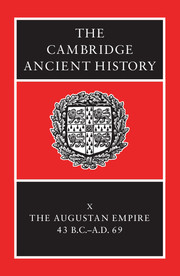14c - Syria
from 14 - The East
Published online by Cambridge University Press: 28 March 2008
Summary
INTRODUCTION
Prologue
Pompey's annexation in 64 B.C. of what remained of Seleucid Syria after the fratricidal struggles of the preceding century, introduced into the Semitic Near East a Roman rule which was to endure for seven centuries. Moreover, as a development and extension of a long period of hellenistic rule, it represented the greater part of almost a millennium of Greco-Roman political dominance and cultural influence. Throughout this long period, however, underlying the Greco-Roman veneer, local indigenous language and culture retained their vitality, to be released in the seventh century by the renewed political dominance of a Semitic people. The point is neatly illustrated by the re-appearance under Islam of many place-names, for centuries overlain by official Greek or Roman ones, but which had apparently remained in oral use amongst the native population.
Yet Roman rule did make an impact in many ways which helped determine the distinctive character of this part of the Near East for several centuries. The creation of conditions of peace and political stability, the unification of the region, the reconciliation of its population to Roman rule and the subsequent participation and influence of many Syrians – most strikingly the Emesene ruling family (below, p. 731) – in and on the developing government and civilization of the Roman Empire, are all the work of the first three centuries.
- Type
- Chapter
- Information
- The Cambridge Ancient History , pp. 703 - 736Publisher: Cambridge University PressPrint publication year: 1996
References
- 1
- Cited by



